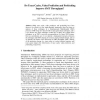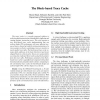ARCS
2006
Springer
14 years 5 months ago
2006
Springer
While trace cache, value prediction, and prefetching have been shown to be effective in the single-threaded superscalar, there has been no analysis of these techniques in a Simulta...
MICRO
1996
IEEE
14 years 5 months ago
1996
IEEE
As the issue widthof superscalar processors is increased, instructionfetch bandwidthrequirements will also increase. It will become necessary to fetch multiple basic blocks per cy...
ISCA
1999
IEEE
14 years 6 months ago
1999
IEEE
The trace cache is a recently proposed solution to achieving high instruction fetch bandwidth by buffering and reusing dynamic instruction traces. This work presents a new block-b...
IEEEPACT
1999
IEEE
14 years 6 months ago
1999
IEEE
Trace cache, an instruction fetch technique that reduces taken branch penalties by storing and fetching program instructions in dynamic execution order, dramatically improves inst...
ISCA
2000
IEEE
14 years 6 months ago
2000
IEEE
Trace caches enable high bandwidth, low latency instruction supply, but have a high miss penalty and relatively large working sets. Consequently, their performance may suffer due ...
ISCA
2003
IEEE
14 years 7 months ago
2003
IEEE
This work examines dynamic cluster assignment for a clustered trace cache processor (CTCP). Previously proposed cluster assignment techniques run into unique problems as issue wid...
ACMMSP
2004
ACM
14 years 7 months ago
2004
ACM
As superscalar processors become increasingly wide, it is inevitable that the large set of instructions to be fetched every cycle will span multiple noncontiguous basic blocks. Th...
IEEEPACT
2005
IEEE
14 years 7 months ago
2005
IEEE
This paper presents a new technique for efficient usage of small trace caches. A trace cache can significantly increase the performance of wide out-oforder processors, but to be e...
IEEEPACT
2006
IEEE
14 years 7 months ago
2006
IEEE
Fast instruction decoding is a challenge for the design of CISC microprocessors. A well-known solution to overcome this problem is using a trace cache. It stores and fetches alrea...




